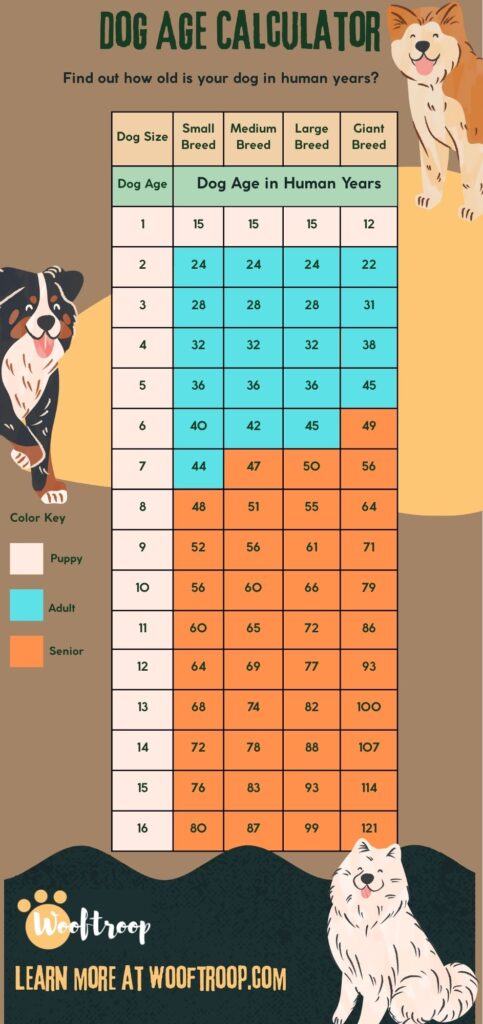Understanding your dog’s real age helps you care for them better. It ensures they get the right care at every life stage. While the classic “1 dog year = 7 human years” rule is well-known, it’s outdated and often misleading. Let’s break it all down.
Why is the “1 Dog Year = 7 Human Years” rule wrong?
The idea that one dog year equals seven human years is not accurate. Dogs grow up much faster in their early years. By the time a dog turns one, it’s already like a teenager or young adult in human age.
Also, a dog’s breed and size make a big difference. For example, Big dogs like Great Danes get old faster. A 6-year-old Great Dane is already a senior. But a small dog like a Chihuahua at 6 years old is still in middle age.
How to calculate dog years to human years
There are two main methods:
2019 epigenetic clock study formula (scientific formula)
This groundbreaking research used DNA methylation to map biological age. Led by UC San Diego, scientists created a logarithmic formula:
Human age = 16 × ln(dog’s age) + 31
This approach reflects how dogs age very fast in the first few years, then gradually slow down. It’s one of the most accurate scientific models available.
Example: If your dog is 3 years old
Human age = 16 × ln(3) + 31 ≈ 48.7 years
- 1 dog year ≈ 31 human years
- 5 dog years ≈ 56.7 human years
- 10 dog years ≈ 67.9 human years
This calculator is based on the 2019 epigenetic aging study by scientists at the University of California, San Diego, which uses DNA methylation to estimate biological age.
How old is your dog in human years?
Use the calculator below to find out your dog’s human age based on breed and actual age.
Dog to Human Age Calculator
📊 Age Curve
🧬 How does this work?
This calculator uses the UCSD 2019 formula published in Cell Systems to convert dog years into human years. It’s based on DNA methylation, giving a more accurate age curve.
Human Age = 16 × ln(Dog Age) + 31
(Based on the UC San Diego 2019 study on DNA methylation and biological aging.)
Source: Science.org – Here’s a better way to convert dog years to human years
By size and breed (most common way)
Dogs age at different rates depending on their size. Smaller dogs live longer and age slower. Larger dogs age faster and live shorter lives.
Small breed dogs
- 1 year = 15 human years
- 5 years = 36 human years
- 10 years = 56 human years
Medium breed dogs
- 1 year = 15 human years
- 5 years = 36 human years
- 10 years = 60 human years
Large breed dogs
- 1 year = 14 human years
- 5 years = 42 human years
- 10 years = 78 human years

Understanding dog aging through my dogs Enzo and Blessy
Life with Enzo and Blessy is basically a real-time documentary on “puppy vs senior dog energy.”
Enzo is two years old, and if we go by the common dog-to-human age chart, he’s a 24-year-old young adult. Scientifically, he’s around 42 in human years. He’s still playful and full of energy, knows the routine, and I love watching him grow.
On the other hand, Blessy is my 11-year-old senior dog, who is about 72 in human years according to the dog-to-human age chart, and around 69 by scientific calculation. She’s a calm, wise old my beloved girl, who prefers to sit quietly in a corner and watch & enjoy everything.

Having both a young and an old dog shows me how fast they grow. Each stage is special in its own way. Puppies teach you patience, while older dogs remind you to slow down and enjoy the little moments. If you pay attention, they’ll show you what they need and teach you more than you expect.
People are born so they can learn to live a good life. Dogs already know how to do that; that’s why they don’t have to stay as long. – W. Bruce Cameron
Who is the oldest dog in the world?
As of the latest records, Bobi, a Rafeiro do Alentejo from a small village in Portugal, holds the title of the oldest dog ever recorded. Born on May 11, 1992, Bobi lived an incredible 31 years and 165 days before passing away in October 2023. That’s not just a long life for a dog, it’s legendary.
Bobi’s story went viral because of how unexpectedly long he lived, especially for his breed. Rafeiro do Alentejo dogs are large livestock guardian dogs, and typically, large breeds don’t live as long. Most have a lifespan of 12–14 years. But Bobi completely defied those odds.
His age was officially verified by the Portuguese government’s pet database (SIAC) and confirmed by Guinness World Records.
Other ways to calculate your dog’s age
Veterinary dental check
Vets often estimate age by checking the condition of your dog’s teeth. More tartar and wear usually mean an older dog. This approach aligns with the 2019 AAHA Dental Care Guidelines for Dogs and Cats, which emphasize dental health as a key indicator of overall well-being and age-related changes.
Behavior & physical signs
Signs like graying fur, slower movement, clouded eyes, or changes in energy can help gauge if your dog is middle-aged or senior.
The 6 stages of a dog’s life
The 6 stages of a dog’s life are typically broken down as follows:
Puppy stage (0-1 year)
- Fast growth and development.
- Learning socialization, house training, and basic commands.
- High energy, playfulness, and curiosity.
Adolescent stage (1-2 years)
- Still energetic, but with more independence and testing boundaries.
- Physical growth slows, but mental maturity continues.
- Some breeds may reach sexual maturity during this stage.
Young adult stage (2-5 years)
- Peak physical health and energy.
- More focused, with some dogs maturing into calm adults.
- Less destructive behavior compared to adolescence.
Mature adult stage (5-7 years)
- Settling into adulthood, with a more balanced energy level.
- May begin showing early signs of aging, but still active.
- Dogs may begin to experience more stable behavior patterns.
Senior stage (7-10 years)
- Gradual decrease in energy and physical capabilities.
- More rest needed, but still mentally sharp.
- Health concerns may arise, including joint issues and dental problems.
Geriatric stage (10+ years)
- Significant slowing down in activity and possible mobility issues.
- Need for specialized care, such as diet and more frequent vet visits.
- Dogs in this stage often need more comfort, attention, and gentle care.
How long do dogs live?
Average lifespan of dogs depend on their breed:
- Small breeds: 12–17 years
- Medium breeds: 10–14 years
- Large breeds: 8–12 years
- Giant breeds: 6–10 years
Longevity also depends on genetics, diet, lifestyle, and preventive care.
Why do smaller dogs live longer than larger dogs?
Smaller dogs usually live longer than bigger dogs for a few reasons:
- Faster Growth – Larger dogs grow faster, which means they age quicker. Their organs and body have to work harder to support their size.
- Pressure on Body – Bigger dogs carry more weight, which puts more strain on their heart and joints. This can lead to health problems like heart disease and arthritis, shortening their lifespan.
- Genetics – Smaller dogs often have fewer health problems compared to larger breeds. Big dogs, like Great Danes, are more likely to develop serious issues such as hip dysplasia and heart problems.
- Growth Rate – Small dogs mature more slowly and don’t go through the fast growth spurts that large dogs do. This helps them avoid strain on their bodies.
So, in short, smaller dogs tend to live longer because they experience less physical stress and have fewer health issues as they age.
Why does your dog’s age matter?
Knowing your dog’s age in human terms allows you to take better care of them. Here’s why it is important:
- Better Care – You can give them the right comfort and support for their life stage.
- Health Checkups – Older dogs need more frequent vet visits.
- Spot Problems Early – Age-related issues like arthritis or vision loss can be caught sooner.
- Right Food – Puppies, adult, and senior dogs need different nutrition.
- Exercise Needs – Young dogs need more activity whereas older ones may need gentle walks.
In short, when you know your dog’s age, you can give them a healthier, happier life.
How to help your dog live healthier and longer?
- Feed a Balanced Diet – Give high-quality food suited to their age, size, and health needs.
- Keep Them at a Healthy Weight – Obesity shortens a dog’s life. Stick to proper portions and avoid overfeeding.
- Regular Exercise – Daily walks, play, and mental stimulation keep their body and brain active.
- Routine Vet Visits – Early detection of health issues can add years to your dog’s life.
- Dental Care – Clean teeth prevent infections that can spread to organs.
- Vaccinations and Parasite Control – Stay up to date on shots and prevent fleas, ticks, and worms.
- Love and Low-Stress Living – A stable, loving environment boosts their emotional well-being.
- Spay or Neuter – It can reduce the risk of certain cancers and behavioral issues.
Caring for their body and mind every day adds up to a longer, healthier life.
They may walk slower these days, but inside, they’re still the toddler who used to demand a cuddle, a toy, a treat, and another cuddle—in that exact order.
Your dog’s age isn’t just a number, it’s a roadmap for how to care for them. Whether they’re a bouncy puppy or a wise senior, knowing where they stand in “human years” helps you give them the love, care, and attention they truly deserve.